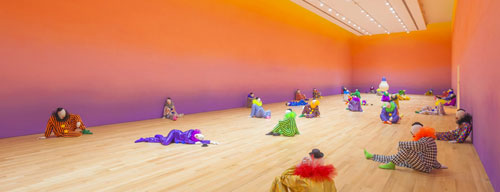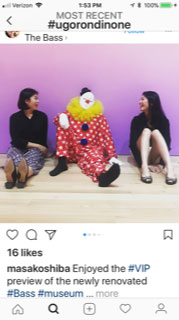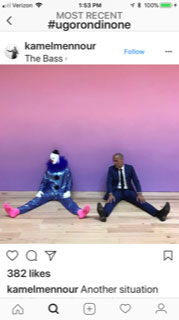Not everyone can or should make art that is deliberately political, that is overtly representing something that will be recognized by others as having political references, content, and purpose. On the other hand the thesis put forward since at least the beginning of the feminist art movement in the early 70s, and in much art writing based on critical theory since the 1930s, and particularly since WWII that all art is political, all cultural work expresses ideology, even when it deliberately, purposefully aims to avoid being overtly political, remains a potent tool of analysis of contemporary art work. Even Bob Ross had political content of some kind in the pacifying effect of his TV show The Joy of Painting and the generic nature of his mark making and image production. It is hard to imagine any art without some sort of a politics as their work’s infrastructure and subtext. It is in that spirit that I look at the many images being posted on Instagram from Miami in recent days and wonder about how the works do or not not address, but certainly embody a political moment–a very dire political moment in the United States, a country where people have come from around the world for decades, indeed for two centuries, to be able to be artists in some kind of state of creative and intellectual freedom, a situation that is rapidly being foreclosed.
From the many images posted this week I have been particularly struck by images of clowns in vocabulary of solitude (2014-2016), an installation of lifecasts of figures dressed and made up as clowns, by the artist Ugo Rondinone in his show good evening beautiful blue at the Bass Museum. The works have all of the desirable characteristics for works favored by museums in the Instagram age: they are brightly arrayed figures in a space that is itself intensely and brightly pigmented and they are non-demandingly interactive, offering endless opportunities for selfies and other pictures. In the Instagram pictures, women are often pictured laughing at the clown, while men mimic the pose of the clown, one of abjection, pathos, impotence.



I understand the appeal of this installation. Just the color alone, minus the iconography, is highly cheery. The child in us is undoubtedly delighted if only by the expanse of bright color–as I write this in New York City it is a dark afternoon of the first snow of the season. I dislike the clowns, always have, but as a small child I loved my clown-like Raggedy Ann and Andy dolls until they were eaten by a family of racoons so I am not impervious the appeal of white face, simple features, and bright color. Rondinone is a much admired and from what I can tell from mutual friends a beloved figure. Nevertheless this image makes me think of one of the most lastingly relevant points in an essay from the 1980s that was one of the most influential in the critique of painting at that time. Here is how I referred to it again in my chapter “Trite Tropes, Cliches or the Persistence of Styles” in my book A Decade of Negative Thinking. In this passage I am talking about a certain type of overwrought representational painting that is a perennial though unnamed substyle of American painting emerging from BFA art programs:
One key to many of these works, particularly the figurative or representational ones, is that meaning is over-determined: the artist is trying to appear interesting or to be seen as saying something (in other words the desire for meaningful expression may be completely sincere, but maybe it isn’t quite as sincere as it wishes to portray) – deer heads in an upside down bathtub, dramatic staircases to nowhere. Self-portrait as clowns: clearly all the young (usually male) artists who continue to image themselves as clowns have never read Benjamin Buchloh’s critical analysis of this imago of the artist’s abject role of jester to the bourgeoisie, in his 1980 essay “Figures of Authority, Ciphers of Regression,” where he writes:“The Harlequins, Pierrots, Bejazzos, and Pulcinelles invading the work of Picasso, Beckmann, Severini, Derain, and others in the early twenties […] can be identified as ciphers of an enforced regression. They serve as emblems for the melancholic infantilism of the avant-garde artist who has come to realize his historic failure. The clown functions as a social archetype of the artist as an essentially powerless, docile, and entertaining figure performing his acts of subversion and mockery from an undialectical fixation on utopian thought.”If they had, they would think twice … or would they? (think of Paul McCarthy’s imago of the artist as a disgusting clown and all the artists influenced by it).
We’ve all been focused in recent weeks on the pathology of male power as harrowing tales of sexual harassment and assault have erupted to the surface of popular culture and news . One of the things that most contributed to my becoming a feminist was my rebellion against the mythology, often supported by women, of male fragility. Even my mother would say that men were basically children. As a teenager, I rebelled: if they are children, I wondered, why the fuck do they have so much power and since they have so much power I am damned if I will make concessions to this idea of them as children. The pairing of the pathology of patriarchal power with masculine pathos–as embodied in the figure of the circus clown–could not engage my sympathy or participation. Not that I don’t feel empathy for men, those who as human beings are aware of the dynamic of patriarchal power and conscious of their part in a system they do not have to utterly obey and that they understand damages them too, even as they benefit from it. And, like most people other than fanatics I am not scrupulously consistent in my judgments: thus this week I have been among those, many of them women, who have felt that Senator Al Franken was railroaded, principally by women politicians. Ironically he began his professional life as a kind of a clown, a comic with a clown’s mask even without makeup, punished for behavior some of which was in the context of clowning for the troops as clown men have for generations. And, ironically, he struggled mightily in his first term to suppress the clown, so that he would be taken seriously as a politician. My attitude may also be a paradox, an inconsistency in a politics.
And so with the imago of the clown to represent people with power, whether to be a successful artist or to damage life on earth like the evil clown currently occupying the White House.
